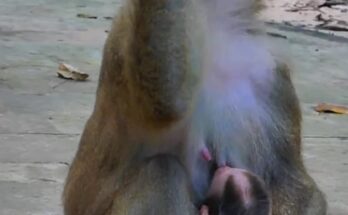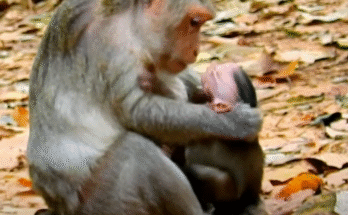In the dim canopy of a dense rainforest, a new life begins. A mother monkey, her fur damp with sweat and effort, cradles a tiny, delicate form against her chest. The newborn monkey, barely the size of her hand, emerges into the world with wide, searching eyes—but no cry escapes its lips. Silent, vulnerable, and trembling, it clings instinctively to its mother’s warmth, a stark contrast to the usual wails of newborns that echo through the jungle.
For most mammals, the first breath comes with a cry—a sharp, instinctive gasp that forces air into the lungs and announces their presence to the world. But this newborn monkey enters existence in hushed serenity, wrapped in a quiet fragility that seems almost unnatural. Its silence is not a mark of weakness but a reflection of the delicate, instinct-driven survival strategies woven into its species’ DNA. In the wild, where predators lurk in the shadows, silence can be a newborn’s first shield against danger.
The mother, a seasoned member of her troop, moves gently, licking her baby’s damp fur with deliberate care. Her large, dark eyes scan the surroundings, ensuring the safety of her vulnerable offspring. Other members of the troop gather in cautious curiosity, some sniffing the air while others peer closely, their expressions a mixture of concern and intrigue. Among them, an older female reaches out to touch the newborn’s tiny fingers—an unspoken welcome into the family.
Still, the baby does not cry. Its small hands grasp tightly onto the mother’s chest, clinging with an unbreakable instinct. The mother supports it with practiced grace, shifting her body slightly to provide warmth and security. As moments pass, the newborn’s breathing steadies, its tiny heart fluttering rapidly beneath paper-thin skin. The jungle hums with the quiet symphony of rustling leaves, distant bird calls, and the occasional chatter of other primates swinging through the treetops. Yet, amidst this natural orchestra, the newborn remains eerily mute.
Why does this baby monkey enter the world without a cry? In some primate species, newborns instinctively suppress vocalizations to avoid drawing unwanted attention from predators. The rainforest, for all its lush beauty, is a realm where survival depends on vigilance. Big cats, eagles, and snakes lurk unseen, always in search of easy prey. The silence of a newborn monkey may be an evolutionary adaptation—one that increases its chances of survival in these first, fragile moments.
As the day unfolds, the mother keeps her baby pressed close, her heartbeat a steady rhythm against its tiny frame. She moves through the trees, navigating the branches with ease, pausing occasionally to groom her newborn with gentle strokes. The baby, still silent, slowly begins to stir. Its small face nuzzles into her fur, seeking nourishment. A tiny hand reaches up, brushing against the mother’s cheek in a quiet plea. She responds immediately, shifting to allow it access to her milk.
With its first sip of warm, life-giving sustenance, the newborn monkey finds its strength. And though it does not cry, its silent tears—droplets of moisture gathering in the corners of its barely-open eyes—speak of the profound journey it has just begun. In this quiet arrival, in the hush of its first moments, the newborn monkey embodies the fragile yet unbreakable resilience of life in the wild.


